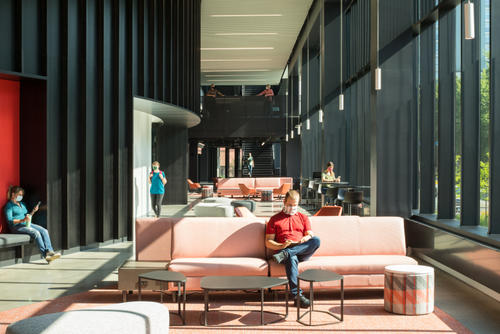University of Minnesota Twin Cities shapes future of healthcare with opening of cutting-edge interprofessional health science facility

The innovative, interdisciplinary education that health science students at the University of Minnesota Twin Cities have enjoyed for years continues to advance on the cutting-edge with the opening of the first-of-its-kind Health Sciences Education Center (HSEC). As the hub for all the University’s health professional schools, HSEC was designed and built to promote interprofessional education and interaction, as well as foster a culture that prioritizes student and faculty well-being.
HSEC is a unique addition to the U of M, already home to one of the most comprehensive health science centers in the nation. It’s also an asset that will benefit all Minnesotans, since the U of M teaches 70% of the state's health professionals, including physicians, nurses, dentists, pharmacists, veterinarians and public health professionals.
“The new Health Sciences Education Center is much more than a building; it is a catalyst for change as we prepare the next generation of health care professionals,” said Mark Rosenberg, MD, vice dean for education and academic affairs in the Medical School.
For Fall 2020, U of M Twin Cities health professional students will be the first to experience the building and programs that will shape the future of healthcare. To welcome health science students to HSEC, the Office of Academic Clinical Affairs and the Office of the Executive Vice President and Provost are hosting a Welcome Week, September 14-18, with treats, giveaways and prize drawings. As part of the University’s efforts to mitigate its spread of COVID-19 on campus, physical distancing practices and facial coverings will be required at all events.
"We respond to changes of practice, but we also drive them," said Jakub Tolar, MD, PhD, vice president for clinical affairs. "By preparing ourselves and our students for the future, we will have a significant impact on our state, our communities, and our personal and professional growth, all of which are closely aligned with our responsibility as a land grant University. We will develop new collective values, a shared recognition of the importance of diversity, new strengths in problem-solving, and a system that rewards courage above conformity."
To meet the academic needs of today’s health science students, HSEC is home to:
- state-of-the-art classrooms, designed for interprofessional learning with active learning and small group teaching spaces;
- the new home of the Center for Health Interprofessional Programs, which allows health professions students a space to connect, collaborate, network and develop;
- innovation and learning support through the Health Sciences Library and Wangensteen Historical Library of Biology and Medicine, which includes a rare book collection, virtual and augmented reality, makerspace and more to support problem-based learning;
- simulation and immersive training that allows health professional students to train in sophisticated, real-world care settings, trainer stations, briefing/debriefing rooms and actor prep areas, and;
- student support and services.
Over the summer, HSEC was used in collaboration with the School of Public Health, Medical School and the Medical Reserve Corps to assist the Minnesota Department of Health in COVID-19 contact tracing. Also, M Simulation used HSEC spaces this summer to train incoming residents and students on personal protective equipment in clinical environments. These are just the earliest examples of the building's multipurpose usability and transformative potential for healthcare education.
“HSEC exemplifies the University's commitment to academic and educational excellence,” said Executive Vice President and Provost Rachel Croson. “It will provide space for interprofessional education and relationship-building, and will serve as a place where formerly distinct components of knowledge can be connected into an interrelated whole. Interprofessional collaboration is the future of healthcare, and this space is further demonstration of how Minnesota is creating that future."
HSEC was funded by Minnesota Governor Mark Dayton’s 2015 Blue Ribbon Commission and the Minnesota Legislature, along with private philanthropic support from generous donors. Minneapolis-based Perkins and Will and Connecticut-based SLAM designed HSEC and Kansas City-based JE Dunn served as the contractor.
For media attendance at HSEC’s Welcome Week, please contact Katrinna Dodge at 715-410-6810. Additional naming opportunities are available. For more information, please contact Catherine McGlinch at 612-626-5456.
{"preview_thumbnail":"/sites/twin-cities.umn.edu/files/styles/video_embed_wysiwyg_preview/public/video_thumbnails/dWg37QEePkI.jpg?itok=4qivHS7o","video_url":"https://youtu.be/dWg37QEePkI","settings":{"responsive":1,"width":"854","height":"480","autoplay":0},"settings_summary":["Embedded Video (Responsive)."]}
- 30 -
About the Health Sciences Education Center
The Health Sciences Education Center (HSEC) on the University of Minnesota Twin Cities campus is a state-of-the-art facility designed to transform health education in Minnesota. As one of the most comprehensive interprofessional education facilities in the country, HSEC is the premier training site for tomorrow’s health professionals.
About the Office of Academic Clinical Affairs
The Office of Academic Clinical Affairs is reimagining health by driving innovation and discovery through collaborations across the University of Minnesota, advancing interprofessional care and training, and being a strong partner to the state, industry and community.
About the Office of the Executive Vice President and Provost
The Office of the Executive Vice President and Provost fosters the academic excellence of the educational and research missions of the University and provides leadership for undergraduate, graduate, and professional education. Through the Office of the Associate Vice President for Academic Health Sciences, the provost promotes and encourages interprofessional education, training, and co-curricular activities across University academic programs in the health sciences.
- Categories:
- Education
- Health
- Education practice and theory




